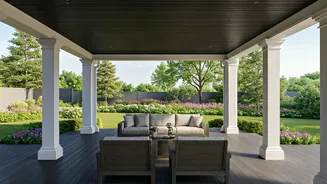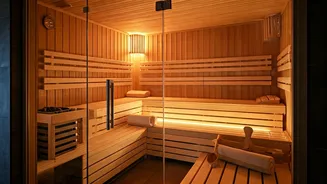Defining the Porch
A porch is a covered structure, usually attached to the entrance of a house. It serves both practical and aesthetic purposes, acting as a transition zone
between the outdoors and indoors. Porches not only protect the main entrance from the elements, but also offer a space for relaxation and social interaction. There are a variety of porch designs, each with unique characteristics and features, suitable for different architectural styles and personal preferences. Considering the design, size, and features of a porch can significantly enhance a home's curb appeal and functionality, adding value to the property. Understanding the fundamentals of porch design is essential for making informed decisions and creating a porch that complements the overall aesthetic of your home, and caters to your lifestyle needs. Porches come in countless styles, from simple and functional to elaborate and decorative, with each option bringing its own distinct charm and benefits. Choosing the right design can transform an ordinary entrance into an inviting and impressive space.
Classic Covered Porch
The classic covered porch is a timeless design, featuring a roof supported by columns or posts, providing shelter from the sun and rain. This style is often found in traditional and colonial homes, exuding a sense of warmth and hospitality. Covered porches can be customized with various roof styles, such as gabled or hip roofs, to match the architectural style of the home. The design often includes a railing and seating area, creating a comfortable outdoor space. Homeowners frequently use these porches for enjoying the outdoors while staying protected from the elements. This design offers an inviting entry point and boosts curb appeal. The covered porch design provides a practical and stylish addition to any home, contributing to both its functionality and visual appeal, offering a welcoming space for residents and guests alike.
Wrap-Around Porches
Wrap-around porches extend around multiple sides of the house, offering extensive outdoor living space. This design is prevalent in Victorian and farmhouse-style homes, known for their spaciousness and charm. Wrap-around porches provide panoramic views and multiple access points, making it easy to enjoy the surrounding landscape. Often equipped with seating areas, swings, and decorative elements, they create an idyllic setting for relaxation and entertainment. These porches encourage a connection with nature, allowing homeowners to enjoy the outdoors from various angles. The extended space often includes areas for dining, lounging, and socializing, making them ideal for gatherings. This design enhances a home's aesthetic appeal and functionality by providing ample space for outdoor activities and creating an inviting atmosphere, perfect for both personal enjoyment and social events.
Screened Porches Defined
Screened porches are designed to offer protection from insects and weather while still allowing enjoyment of the outdoors. These porches have screened walls, allowing for ventilation and natural light. They are perfect for regions with significant insect populations or unpredictable weather, providing a comfortable space to relax. Screened porches often feature comfortable seating, creating a cozy and inviting atmosphere. They can be furnished and decorated to match the style of the house. This design offers a versatile outdoor living space that can be used throughout the year, regardless of the weather. These porches are suitable for dining, entertaining, and simply unwinding in a bug-free environment. Screened porches provide a unique blend of indoor comfort and outdoor access, enhancing the overall functionality and enjoyment of a home.
Open Porch Styles
Open porches, characterized by their lack of screening, provide unobstructed views and access to the outdoors. These porches are often found in modern and contemporary homes, emphasizing clean lines and simple designs. Open porches offer a versatile space for enjoying the outdoors, perfect for sunbathing or casual seating arrangements. The design can range from small, functional entryways to large, expansive decks, tailored to suit the homeowner's preferences. Open porches blend seamlessly with the surrounding landscape, providing a direct connection to nature. They are often complemented by comfortable seating, creating a welcoming atmosphere. These porches are a great way to enhance the home's curb appeal and functionality, offering a space for relaxation and enjoyment. Open porches provide a flexible and inviting outdoor space, suited for a range of activities and styles.
Portico Design Basics
A portico is a covered entrance supported by columns, typically attached to the front of a house. This design is prevalent in classical architecture, often seen in Greek and Roman-inspired homes. Porticos serve as a grand entryway, creating a sense of elegance and sophistication. The design typically includes columns, a roof, and sometimes a pediment, enhancing the home's curb appeal. Porticos can vary in size and style, from simple designs to elaborate structures, all contributing to the aesthetic appeal. They provide a sheltered entry, protecting visitors from the elements and adding visual interest. This architectural detail is a statement of elegance, making a striking first impression. A well-designed portico enhances the home’s overall design, creating an inviting and stylish entrance that elevates its curb appeal and adds value.
Choosing Materials Wisely
Selecting the right materials is crucial for a porch's durability and aesthetics. Wood remains a popular choice, offering a warm and natural look, but requires regular maintenance. Composite materials, such as those made from recycled plastic and wood fibers, offer low-maintenance alternatives with enhanced durability. Stone and brick add a touch of elegance and provide excellent weather resistance. Metal, especially wrought iron, can provide a classic, decorative element. Concrete is a versatile material, offering durability and flexibility in design. When selecting materials, it's essential to consider factors like climate, budget, and personal preferences. Selecting the right materials ensures the porch withstands the elements and maintains its beauty for years. The appropriate choice of materials determines the porch's lifespan, maintenance needs, and overall appearance, contributing significantly to the home's aesthetic and practical value.
Adding Design Elements
Incorporating design elements elevates a porch's aesthetic appeal and functionality. Adding comfortable seating, such as rocking chairs, swings, or sofas, transforms the space into a relaxing retreat. Decorative elements like potted plants, hanging baskets, and outdoor rugs add color and personality. Lighting, including pendant lights, lanterns, and string lights, creates ambiance and enhances the porch's appeal during the evening. Adding curtains or blinds provides privacy and protection from the sun. The incorporation of personalized touches, such as artwork, mirrors, or decorative pillows, can reflect your style. Careful use of these elements can customize the porch to match your home's character and your personal taste. Thoughtful design elements transform a functional area into a stylish and comfortable extension of the home, boosting both appeal and livability.













